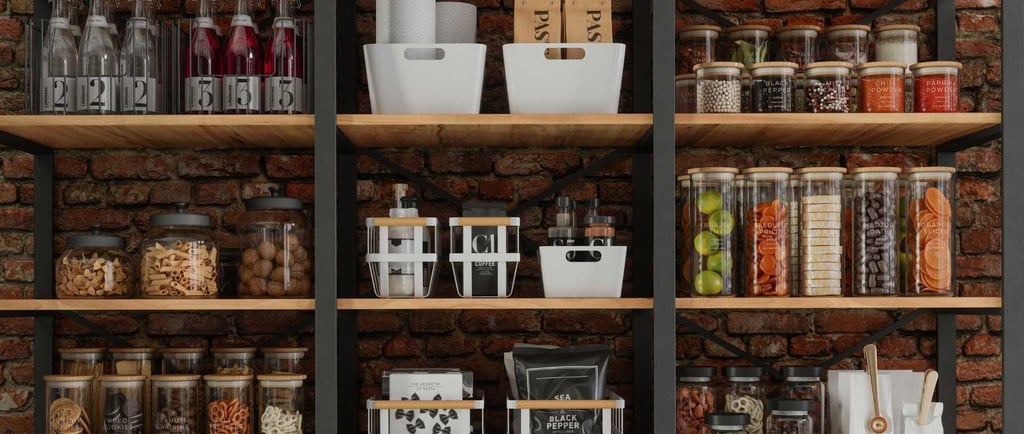A Step-by-Step Guide to Organizing Your Kitchen Like a Pro
10/31/20253 min read


1. Start by Decluttering and Assessing What You Have
Before organizing, take time to evaluate what’s in your kitchen. Many people accumulate duplicates, expired ingredients, or appliances they rarely use. Start by emptying your drawers, cabinets, and pantry completely. Group similar items together — such as cookware, utensils, or dry goods — and decide what to keep, donate, or discard.
Check expiration dates and remove old spices, sauces, or canned foods. If you have multiple gadgets that serve the same purpose, keep the one you use most frequently. For example, you might not need both a hand mixer and a stand mixer if one can handle most tasks.
Decluttering not only frees up space but also gives you a clear understanding of what needs better storage. The goal is to only keep what adds value to your daily cooking routine.
2. Plan Your Kitchen Zones for Maximum Efficiency
Professional chefs and kitchen designers often use the “zoning” principle — grouping items by their function. This ensures that everything you need for a specific task is close at hand.
Here are five key kitchen zones you can set up:
● Cooking Zone: Store pots, pans, cooking utensils, oils, and spices near the stove.
● Preparation Zone: Keep knives, cutting boards, mixing bowls, and measuring tools in the counter area where you do most of your prep work.
● Storage Zone: Dedicate one area for dry goods and another for refrigerated items. Use clear containers for better visibility.
● Cleaning Zone: Place dish soap, sponges, and towels near the sink and dishwasher.
● Serving Zone: Keep plates, cutlery, glasses, and serving bowls close to the dining area.
When zones are properly arranged, you minimize unnecessary movement, save time, and make your kitchen more intuitive to use.
3. Maximize Cabinet and Drawer Space
Even the smallest kitchen can feel spacious with the right storage techniques. Vertical and pull-out storage options are key to optimizing every inch.
● Use drawer dividers to separate utensils and tools, making it easier to find what you need.
● Install pull-out shelves or lazy Susans in lower cabinets to access items stored in the back.
● Stackable containers and riser shelves help you use vertical space efficiently in cupboards.
● Add hooks or magnetic strips on cabinet doors or walls for hanging tools, measuring spoons, or pot lids.
If you’re short on counter space, consider using a wall-mounted rack for spices or knives. Transparent containers not only look tidy but also let you quickly see when supplies are running low.
Organizing isn’t just about aesthetics — it’s about creating a system that works for your habits and available space.
4. Keep Your Pantry and Refrigerator Organized
Food storage areas often become messy quickly if not maintained properly. The key is to make everything visible and accessible.
For pantries, use clear bins or baskets to group similar items — baking ingredients, snacks, grains, or canned goods. Labeling containers prevents confusion and encourages consistency. Store everyday items at eye level and less frequently used ingredients on higher shelves. Use airtight containers to preserve freshness and prevent pests.
For refrigerators, follow the “first in, first out” rule to minimize waste. Store perishable items at the front, and use drawers and shelves strategically — dairy on upper shelves, meats on the lowest, and fruits and vegetables in crisper drawers. Adjustable shelves can help accommodate taller bottles or leftovers.
Regularly checking your pantry and fridge ensures you use what you have before buying more — saving money and keeping things tidy.
5. Adopt Daily Habits to Maintain Organization
The most organized kitchens can quickly become cluttered without consistent habits. Setting up simple daily routines keeps everything in order with minimal effort.
● Clean as you cook. Wipe surfaces, wash tools, and return items to their place immediately after use.
● Do a five-minute reset every evening. Clear counters, load the dishwasher, and empty the sink before bed.
● Check your inventory weekly. Before grocery shopping, review what you already have to avoid duplicates.
● Rotate items regularly. Move older products to the front of shelves to ensure they’re used first.
● Reevaluate your setup every few months. As your cooking habits change, adjust your layout accordingly.
Consistency is what turns an organized kitchen into a lasting system rather than a one-time project.
Final Thoughts
An organized kitchen is not just about neatness — it’s about creating a space that supports your cooking goals and daily routine. When your tools and ingredients are easy to find, meal preparation becomes smoother and more enjoyable. Start by decluttering, design your zones thoughtfully, and invest in smart storage solutions. Maintaining order through small daily habits ensures your kitchen stays functional and beautiful over time. With the right structure in place, you’ll spend less time searching for things and more time doing what you love: cooking and sharing great food.
A well-organized kitchen is the foundation of efficient cooking and stress-free mealtime preparation. When everything has its place, you can cook faster, reduce food waste, and even enjoy the process more. Whether your kitchen is large or small, open or compact, smart organization can completely transform how you use it. This guide walks you through proven strategies and practical steps that professionals use to create a tidy, functional, and visually appealing kitchen.